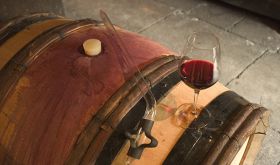6 July 2015 ‘We wanted to do a punk rock TV show. And when we were growing up, the way to be punk rock was to be really liberal, because we grew up with Reagan in high school and all that. Then the problem was, we moved to LA, and the only way to be punk rock in LA is to be a Republican. You know, you’re at a party and the only way is to be “I think George Bush is awesome,” and people are like “WHAT?!?” Really, I mean, it’s amazing.’
This is a snippet from an interview in which the great satirist of our age, Trey Parker, explains why his writing often presents a seemingly contradictory fusion of liberal and conservative ideals. The key idea here – obvious once stated, but not necessarily before – is that rebellion is moulded by local conditions. (The picture on the right shows him committing an act of minor rebellion with his Peabody Award in 2006.) The repertoire of Parker’s rebellion was formed in two contrasting places, rural Colorado and Los Angeles, and hence his output has acquired characteristics that can be traced back to both. In wine terms, then, South Park is Penfolds Grange: an iconic multi-regional blend.
Grange itself may be firmly ensconced in the fine-wine establishment these days, but was created in a spirit of defiance. Its winemaking approach – fermented dry, unfortified, extracted for the long haul and aged in new oak – was borrowed from Bordeaux, but in 1950s Australia was considered seditionary. Six years into production, its creator Max Schubert was ordered to stop. He didn’t, and the rest is history.
Similar insurrection is underway in California at the moment, albeit with far more protagonists. A new wave of producers is challenging the post-1997 orthodoxy which favours late picking, high alcohol, dark colour, low acid and glossy texture. A wine like Kutch McDougall Ranch Pinot Noir 2013, which I encountered while judging the Decanter World Wine Awards this year, represents an extreme swing away from the customary California style, with 100% whole-bunch fermentation and only 12.2% alcohol. It is more than just a statement of intent, a hard-line demonstration of what California Pinot can be; it is a successful wine in its own right. It won a Regional Trophy, and there are many Pinots of equal merit amongst its peers.
Rebellion is necessary to keep wine production healthy. Without it, stagnation would set in, and for a very particular reason. When one style dominates in a certain place for too long, we (the writers and merchants) have a natural tendency to ascribe its characteristics entirely to the place itself. The human element, the influence of local culture, fades from view. In other words, entrenched local wine character becomes attributed unquestioningly to terroir.
Meursault is a paradigm example of this false ascription. When I was first learning about burgundy, received wisdom stated that Puligny is steely, and Meursault is buttery. These were held up as immutable characteristics of the two neighbouring villages, and I still hear them trotted out from time to time. It is certainly true that buttery Meursault exists, and that buttery Puligny is, in practice, something of a contradiction, but this is quite unrelated to terroir. Certain influential Meursault producers, in particular Comtes Lafon, happened to make a buttery style, and this association has percolated through the collective wine consciousness, solidifying as it went.
Nobody who tastes Coche-Dury, Roulot, Ente, Pierre Morey, Fichet, or a dozen other top producers of Meursault would dream of calling their wines buttery. While there is a tendency to fullness of texture, these wines have a firmness and tension that makes them far ‘steelier’ to my mind than many a floral, fruity Puligny. When Mounir Saouma of Lucien Le Moine says ‘Meursault is mineral, Puligny is sweet’, people raised in the buttery-steely tradition boggle and splutter, but this is in fact a wholly accurate description of his own wines, and indeed of many others grown in the same spot.
This is not to say that the association of butteriness with Meursault is groundless – on the contrary, this is a local character of that commune. But the origin of the character is cultural rather than geological. It is born of people, not pebbles.
Every now and again, the opinion is aired that the definition of ‘terroir’ should include local culture. The argument is typically made that, since human influence on a wine is just as important as soil, drainage, exposition, altitude, climate and so on, it should be bundled together with those natural factors under the one umbrella term. This does not follow. The success of a definition is measured by how usefully it demarcates concepts, and by extending the meaning of ‘terroir’ to encompass all local influences, geographical and cultural, I would say its utility is greatly diminished.
This is because local culture is both mutable and optional. You can choose to operate entirely within traditional parameters, or you can rebel. Changes to local practice occur within a generational timeframe, not a geological one. On the other hand, the physical characteristics of a vineyard, while not strictly permanent thanks to processes such as erosion and climate change, are not under winemaker control. You cannot rebel against these.
By keeping human influence separate from our definition of terroir, a more interesting picture emerges of their relative contribution to wine character. It seems to me that strict (geographical) terroir sets the overall agenda, the broadest stylistic limitations particularly regarding ripeness and maximum potential quality. Let’s call this the macro-influence.
Terroir is also responsible for the final, intimate details of a wine’s character, the differences between two single-vineyard bottlings made in the same way by the same person. It explains why Meursault Perrières tastes different from Meursault Charmes, Red Rock Terrace from Gravelly Meadow, Calvert from Cornish Point. This is the micro-influence.
Between the macro- and the micro-influence, the limits of what is achievable and the subtlest nuances of character, the human element prevails. The vast sequence of decisions that constitute vineyard management and winemaking process is what makes a Meursault buttery or not-buttery, a California Pinot vigorous or soupy, a Shiraz port-like or Bordeaux-like. These mid-scale stylistic markers are largely unrelated to terroir.
Without adopting this view, it is easy for the taster to get tripped up. Richard has written eloquently on ‘the Wolf Blass incident’, in which many talented MW students once misidentified that producer’s Yellow Label Chardonnay as a serious white burgundy. I am convinced that blind tasting used to be easier, as local winemaking cultures tended to be more isolated [couldn’t agree more – JR MW]. What we thought of as peculiarities of national or regional terroir – for example, the tendency of Australian Chardonnay to be heavy and tropical, and nothing like fine burgundy – were in fact manifestations of regional tradition. The fact that winemakers now travel more, and like many forms of 21st century culture, their regional tradition operates on a more fluid, international basis than before, can give rise to the illusion that terroir is in decline.
It isn’t. Cultural pseudo-terroir may be less regionally distinct than it once was, but terroir proper inevitably persists. We are merely being forced to accept that its influence is more limited than we might have hitherto thought. By defining terroir more narrowly, we can better appreciate the extraordinary relationship the vine cements between constant, unyielding Nature and those mercurial, rebellious creatures who seek to capture her in a glass of wine.














